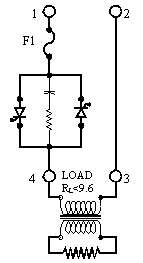I contiuned to test the SCR part today. When I turned on the system, I could measure the firing angle signal from C-2154 board. But I have not measured the high voltage. After warming up several minutes, even I did not send the firing angle signal, I could monitor the high voltage. This phenomenon might be caused by the bad SCR?
I found an interesting paper about the inverse parallel thyristor written by Dr. Henry E. Payne.

Figure. 1
| | Fig.1 illustrates a typical installation of a 50A single-phase thyristor unit phase-angle controlling a 480ac voltage to the input of a transformer with a low-voltage resistive heater connected to the transformer secondary.
Note the resistance value: RL. All properly designed thyristor controls will have certain minimum resistance loads that they are able to control, if, for no other reason, because this minimum resistance must be large enough to limit the current through each thyristor to its rating when it switches into the ON state. From OHM's Law this value is, typically, the RMS mains voltage divided by the maximum nameplate current rating of the power control.
And for a direct-connected resistance heater, this would be a correct value.
HOWEVER, some might also assume that this is the same value when connecting an SCR power control to a transformer. IT IS NOT. All transformer primaries will have a DC resistance value much lower than the primary voltage divided by the primary current rating. As a result the maximum current that can flow through the loop 1-4-3-2 is limited only by RL and whatever system impedance is available at terminals 1 and 2. If F1 is selected properly to protect the two SCRs and there is no consideration given to the transformer RL, it is very likely that one will have nuisance fuse blowing during normal operation of the system due to the transformer magnetizing current inrush.
When SCRs are either in the OFF state or in operation, one cannot assume that they will not misfire due to some line transient. After all, that is the reason that all properly-designed SCR controls will always have an RC network connected across the SCRs as shown in Fig.1. The RC network and the dv/dt rating of the SCR combine to prevent over 90% of the line noise from causing a misfire. Nonetheless, there is always a bigger transient on the mains, and every solid-state power control must be designed to allow for that inevitability. By over-sizing the SCR/fuse combination for transformer or other high-inrush loads, one can assure oneself that nuisance fuse blowing is unlikely to occur, nor will there be any fatigue damage to the fragile, silicon SCR pellet.
Finally, one must also ensure that phase-angle control --see Fig.2-- of the transformer primary always impresses a symmetrical ac voltage on the primary with no significant dc component. The latter can cause saturation of the transformer core, which will lead to excessive current and temperatures which cannot be tolerated for long-term operation. Transformers and other inductive loads require full-cycle gating of the SCRs to ensure that the SCRs will remain in the ON state, regardless of the inductive load characteristic (where the load current may lag the SCR voltage by 90 degrees or more). | |

Figure. 2
|
http://www.payneng.com/AN11-18/AN11-18.htmThyristor Theory and Design Considerations(PDF)




No comments:
Post a Comment